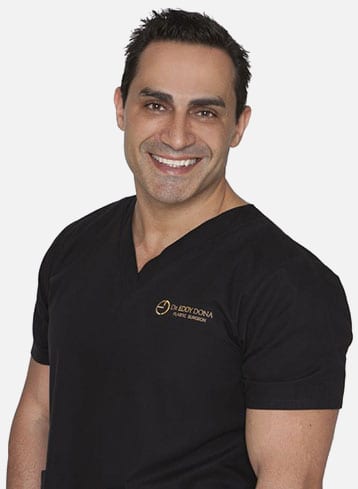Saline vs Silicone Breast Implants
Tue 1st Mar 2022
Comparing Silicone & Saline Breast Implants
Breast Augmentation is one of the most common cosmetic surgical procedures worldwide. While Breast Augmentation surgery has seen significant advancements over the past couple of decades, one thing that hasn’t changed is the materials used. That is, you still have two main options: silicone or saline implants.
Are you considering undergoing Breast Augmentation but want to know the difference between saline or silicone implants? This article will try to break down some of the key differences and myths about silicone and saline breast implants to help you make an informed decision about which type of breast implant is right for you. Ultimately, formal consultation with Dr Dona will be the best way to determine which breast implant type, size, and shape will be optimally suited for your breast anatomy and aesthetic goals.
Summary – Dr Dona only use silicone implants
The Curious History of Breast Implants
Understanding the history of Breast Augmentation surgery encourages us to appreciate just how far the procedure and materials have come since the late 19th century. In the late 19th century, some surgeons injected paraffin wax to enlarge patients’ breasts. This however left patients susceptible to infections and paraffinomas which triggered cancers, while also destroying the breast aesthetic with wax clumping and creating hard lumps.
The advent of dubious materials being injected into the breasts during augmentations continued into the early 20th century. Carcinogenic and ineffective materials including vaseline, olive oil, rubber, animal cartilage, sponges and even glass were inserted into the breasts. As you can imagine, these methods proved to be as dangerous and successful as the paraffin wax from the 19th century.
The first silicone gel implants were introduced in 1960’s – things have come a long way since then.
Breast Implant Innovation
When first introduced into the marketplace, breast implants were exempt from regulatory scrutiny, which enabled the crude beginning of breast implants. Currently, breast implants are heavily regulated by the Therapeutic Goods Association (TGA) in Australia.
Technologies used to make breast implants have made tremendous strides. Implant manufacturers have experimented with the thickness of the outer shells as well as the density of the filler material to create different looks to match different preferred outcomes. An enormous variety of implant shapes and profiles allows a surgeon to choose a size and shape implant to optimally suit the patient’s body and preferred aesthetic outcome.
Silicone Breast Implants
Silicone implants are comprised of silicone shells or pockets that are pre-filled with a silicone gel. The silicone gel is a thick, sticky fluid that closely mimics the look and feel of natural breast tissue. Silicon gel and the silicon shell are biocompatible materials suitable for living tissue. Silicones can be found in everyday items, such as antiperspirants, shaving creams, shampoos, cooking utensils, soaps, laundry detergents, fabric conditioners and contact lenses, so you have likely already been in contact with silicone.
The risk of spontaneous rupture or leaking of modern-day implants is also significantly lower than saline implants and older versions of silicone implants.
Silicone Breast implants are significantly more durable than saline implants. The chance of a rupture is extremely low, although it can happen within six months after surgery or many years later. If a rupture does occur, it’s generally not something that causes a problem; you typically don’t develop any pain or issues like that. However, if a rupture does occur, your implant will still need to be removed and replaced.
Saline Breast Implants
Saline breast implants are comprised of a silicone shell similar to silicone implants, with the exception that the implants are filled with a saline solution as opposed to a silicone gel. These are biocompatible materials that are suitable for living tissue.
If the implant shell of a saline implant ever ruptures or leaks, the implant simply collapses. The saline is absorbed and naturally expelled by the body; however, the affected breast would deflate back to its unaugmented state. Surgery would be necessary to remove the silicone shell.
Are Saline or Silicone Breast Implants Recommended?
Generally speaking, a silicone implant will be the recommended choice in most cases. Silicone implants give the breast a much more natural feel and curvature than saline-filled implants whilst being significantly more durable.
Which Type of Implant Is ‘Safer’: Silicone or Saline?
The Therapeutic Goods Association in Australia heavily regulates both silicone and saline implants. Having said that, with few exceptions, the vast majority of Australian surgeons use silicone implants.
Why Most Plastic Surgeons Prefer Silicone Breast Implants
Dr Dona exclusively uses silicone implants as he feels that they provide an optimal result for his patients. Silicone breast implants continue to be the most popular choice for Breast Augmentation in Australia and overseas because of their more natural appearance, softer touch, longer-lasting results and aesthetic outcome.
If you are considering undergoing Breast Augmentation Surgery, book a consultation with Dr Dona. Please call us on 1300 373 662 or email us at [email protected]
